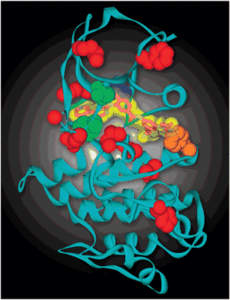Authors Christopher Chen and Aaron Kesselheim review how various market strategies slowed the entry of generics of leukaemia treatment Gleevec (imatinib) in the US [1].
Imatinib is a protein kinase inhibitor that potently inhibits the activity of the Bcr-Abl tyrosine kinase (TK), as well as several receptor TKs, and which is used to treat leukaemia.
At its introduction in 2001, the originator drug, Swiss pharma giant Novartis’ blockbuster Gleevec, had a list price of US$26,400/year in the US. This had risen to US$120,000/year at the time of generics entry. In 2015 alone the drug had sales of US$4.7 billion. The high price of Gleevec has been linked to patient non-adherence.
Sun Pharmaceutical Industries (Sun Pharma) launched generic version of Gleevec (imatinib mesylate) in the US in February 2016 [2]. In Canada a generic version was already available in 2013 and the European Medicines Agency (EMA) approved a generic version of imatinib in October 2012 [3].
The initial US patent on Gleevec was set to expire in May 2013. However, Novartis obtained an additional six-month (180 days) paediatric exclusivity extension, which is given to companies that respond to the US Food and Drug Administration (FDA) request to carry out a clinical trial in children. In addition, the company obtained 586 days of patent term restoration, to compensate for the time FDA took to review its application. This extended Gleevec’s protection from May 2013 to July 2015.
Novartis also sought numerous additional patents on imatinib. Secondary patents have become widely used by brand-name manufacturers to extend the life cycle of patented products. In 2007, brand-name manufacturers listed with FDA an average of 10 patents per drug compared with an average of two patents per drug in the previous decade. In the case of Gleevec, secondary patents covering a different formulation of the active ingredient further extended its potential market exclusivity from July 2015 to November 2019.
Sun Pharma challenged the secondary patents on Gleevec and in May 2014 the two companies settled their litigation with Sun Pharma being allowed to launch its generic version in February 2016 [2]. This could be seen as a success that the generic was launched before 2019. However, according to Chen and Kesselheim, ‘an alternative viewpoint is that Novartis won an additional nine months of exclusivity for its branded product by using questionable patents, which allowed it to earn more than half a billion dollars during that time’.
A factor that may affect the uptake of generics in the US, according to Chen and Kesselheim, is the 180-day exclusivity. During its 180-day exclusivity for generic imatinib, Sun Pharma priced its generic product at 30% below the brand-name price. By comparison, in Canada, generic imatinib is sold for approximately 82% below the brand-name price.
Another factor that may affect the uptake of generics is the introduction of second-generation products. According to Chen and Kesselheim ‘it is common practice for pharmaceutical manufacturers to develop separate but related products to their blockbuster drugs and invest heavily in marketing that is intended to shift prescribing to the newer, patent-protected product as market exclusivity on the first drug expires’. In the case of imatinib, Novartis has launched advertising campaigns to steer oncologists away from imatinib and toward Tasigna (nilotinib), which was approved for treatment of leukaemia in 2008. Tasigna has an annual list price of US$115,000 and is under patent protection until 2026. Nilotinib generated US$1.6 billion in sales in 2015, up from US$425 million in 2014.
Other factors that influence generics uptake include physician and patient scepticism about the equivalence of generics and expanded copayment schemes for the brand-name drug after generics hit the market. Novartis also retains a secondary patent on the use of imatinib for the treatment of GI stromal tumours (GIST).
The authors conclude by making the following recommendations:
- that there needs to be greater scrutiny of drug patent applications by the US Patent and Trademark Office (USPTO)
- the highlights of so-called pay-for-delay deals should be published
- clinicians should take a more active stance in educating their patients about the safety of generics
Conflict of interest
Disclosures provided by the authors of the research paper [1] are available at jop.ascopubs.org.
Related article
Generic imatinib non-inferior to Gleevec
References
1. Chen CT, Kesselheim AS. Journey of generic imatinib: a case study in oncology drug pricing. J Oncol Pract. 2017:JOP2016019737. doi:10.1200/JOP.2016.019737. [Epub ahead of print]
2. GaBI Online - Generics and Biosimilars Initiative. Sun Pharma launches imatinib mesylate in the US [www.gabionline.net]. Mol, Belgium: Pro Pharma Communications International; [cited 2017 Jun 9]. Available from: www.gabionline.net/Generics/News/Sun-Pharma-launches-imatinib-mesylate-in-the-US
3. GaBI Online - Generics and Biosimilars Initiative. EMA approves first generic imatinib [www.gabionline.net]. Mol, Belgium: Pro Pharma Communications International; [cited 2017 Jun 9]. Available from: www.gabionline.net/Generics/General/EMA-approves-first-generic-imatinib
Permission granted to reproduce for personal and non-commercial use only. All other reproduction, copy or reprinting of all or part of any ‘Content’ found on this website is strictly prohibited without the prior consent of the publisher. Contact the publisher to obtain permission before redistributing.
Copyright – Unless otherwise stated all contents of this website are © 2017 Pro Pharma Communications International. All Rights Reserved.








 0
0











Post your comment